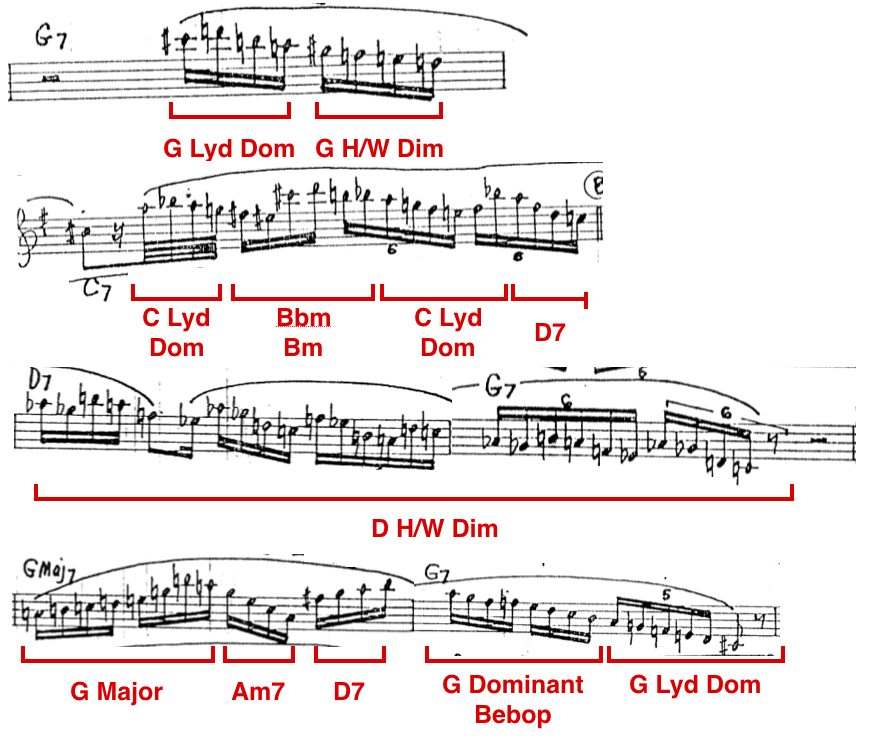Coinage
The term ‘Sheets of Sound‘ was coined by music critic Ira Gitler in the liner notes of the Coltrane album Soultrane (1958). He used it to describe the Coltrane’s improvisational style at the time.
Coltrane
John Coltrane’s music can be broken into roughly 3 periods:
- Vertical (Sheets of Sound)
- Horizontal (Modal Jazz)
- Experimental (Free Jazz)
And his Sheets of Sound technique falls into the Vertical period which was in the late 1950’s and can be found on albums like:
- Blue Train
- Soultrane
- Thelonious Monk Quartet with John Coltrane at Carnegie Hall
- Milestones (Miles Davis Album)
- Any other late 1950’s Coltrane album
Verticality
As we covered in a previous lesson, to improvise vertically means to think in terms of chords and chord progressions – so your solo traces out each individual chord in the progression. While to improvise horizontally means to think in terms of scales, modes and keys – so your solo isn’t tracing out each individual chord, but rather you are just playing a particular scale over the entire progression. The end result can be very similar. A vertical solo can sound exactly the same as a horizontal solo – it’s just a different way of thinking about improvisation.
Sheets of Sound
And so the Sheets of Sound technique is a vertical improvisation technique; that is, it uses arpeggios, patterns, licks and scales that trace out each chord in a progression.
So let’s say we are playing a song, and we have the chord G7 for a full bar. Now, let’s just list a few scales and arpeggios that you could plausibly use to improvise over this chord:
- G7 arpeggio
- G13♭9 arpeggio (extension)
- D♭7 arpeggio (tritone substitution)
- D♭13♭9 arpeggio (tritone substitution with extension)
- Am7 | D7 (II-V)
- G Mixolydian (C Major)
- G Wholetone
- G H/W Diminished Scale
- G Lydian Dominant (D melodic minor)
- G Altered Scale (A♭ melodic minor)
- G Blues Scale
- G Major Pentatonic
- We could keep going, but let’s stop there…
If you play all of these scales/arpeggios in their entirety over those 4 beats of G7, you are playing Sheets of Sound. Now, obviously, this is impossible so you just try squeeze in as much as you can.
Coltrane tried to squeeze every possible harmonic implication into his solo – play every possible chord and every possible scale for each chord.
This is still a vertical approach because we have chosen our scales and arpeggios based on the chord.
Breaking that down, the Sheets of Sound technique involves:
- Playing really really fast – using slurred glissandi
- Playing asymmetrically with odd groups of notes (groupings of 5, 7, 9, 11, 13, 15, etc.)
- Sweeping between high and slow registers
- Superimposing new chords over the existing chords (playing a D♭7 arpeggio over the G7 chord)
Avoid Notes
As we discussed in a previous lesson, an Avoid Note is a note that sounds dissonant over a particular chord. But, despite their name, avoid notes CAN be used to improvise IF they are used as quick passing notes and are NOT sat on for long periods of time or overemphasised.
But if everything you play is super fast (a la Sheets of Sound), then every note you play effectively becomes a passing note (and thus they all become equally unimportant). This means you can literally play any note or chord that you like, because you are passing through each individual note so quickly. So using the Sheets of Sound technique allows you to play absolutely anything you like – ignoring avoid notes.
Coltrane Quote (Down Beat, Sept 29, 1960)
Coltrane himself, when discussing his technique in an interview, said the following:
“About this time, I was trying for a sweeping sound. I started experimenting because I was striving for more individual development. I even tried long, rapid lines that Ira Gitler termed “sheets of sound” at that time. But actually, I was beginning to apply the three-on-one chord approach, and at that time the tendency was to play the entire scale of each chord. Therefore, they were usually played fast and sometimes sounded like glisses.”
“I found there were a certain number of chord progressions to play in a given time, and sometimes what I played didn’t work out in eighth notes, 16th notes, or triplets. I had to put the notes in uneven groups like fives and sevens in order to get them all in.”
“I could stack up chords, say on a C7, I sometimes superimposed an Eb7 up to an F#7, down to an F. That way I could play three chords on one. But on the other hand, if I wanted to, I could play melodically…”
Transcription
We can have a quick look at an extract of a transcription of Coltrane’s solo over Straight, No Chaser on Miles Davis’ album Milestones.

Coltrane Solo begins around 4:00
So as you can see, Coltrane is:
- Playing through all the notes very quickly
- Grouping them in odd numbers
- Using a whole bunch of different scales and arpeggios
It’s almost like every beat has a brand new scale; he’s layering sheet after sheet of new scales, one over the other – thus the term Sheets of Sound.